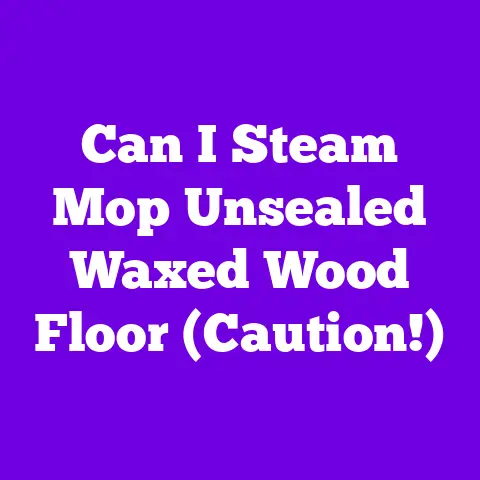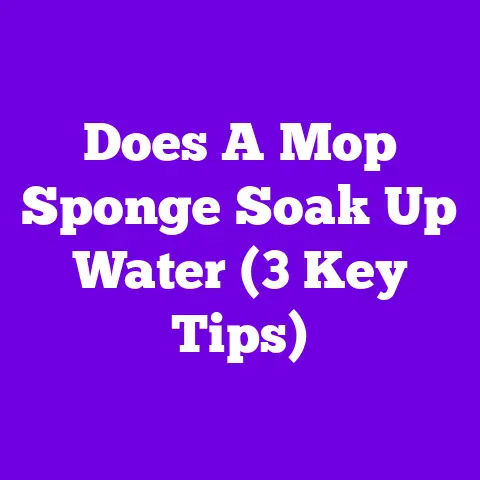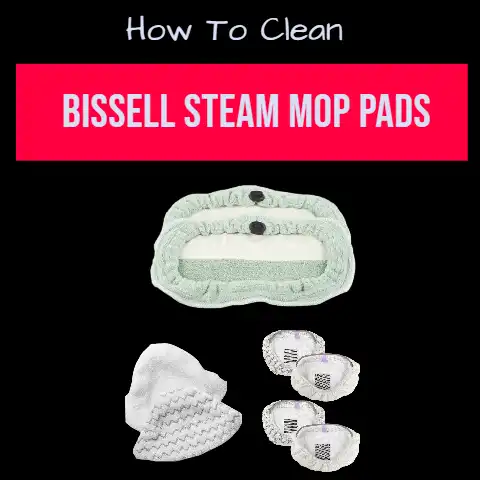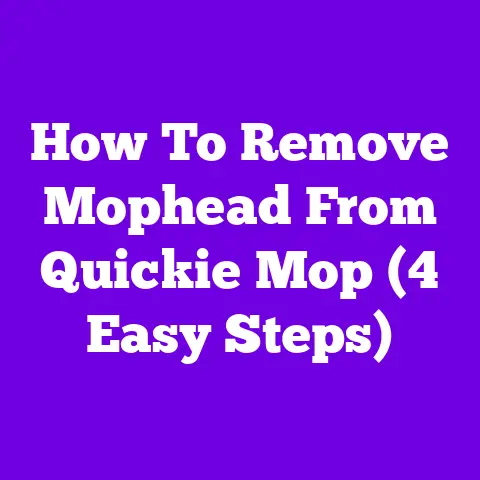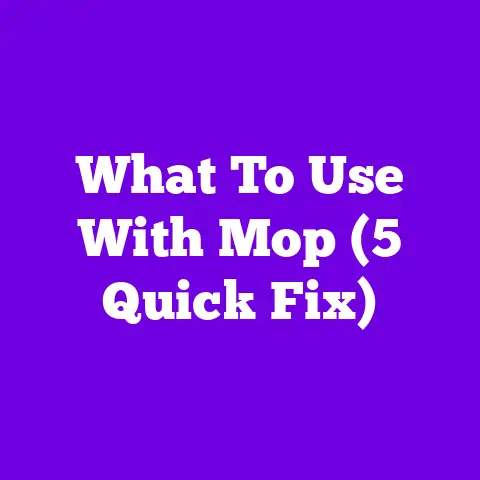Which Dust Mop For Concrete Floors (Best Choice)
Which Dust Mop for Concrete Floors: Best Choice Explained
Have you ever wondered why your concrete floors still seem dusty despite hours of cleaning? I remember when I first started working as a janitor in a busy office building with sprawling concrete floors. My initial attempts at keeping them spotless were frustrating. It felt like the dust had a mind of its own, no matter how much I mopped. That’s when I began exploring the world of dust mops designed specifically for concrete floors. Let me share my journey, some personal experiences, and what I’ve learned along the way.
My Journey with Concrete Floors
Concrete floors are both a blessing and a curse. Their durability is unmatched, making them perfect for high-traffic areas like warehouses, garages, and industrial facilities. However, their rough texture can trap dust and debris, making cleaning a challenge. I once worked at a school with endless hallways of concrete flooring. The students loved to run up and down, leaving a trail of dirt and dust in their wake. That’s when I realized the importance of using the right tools.
The Warehouse Saga
In one of my early jobs at a massive warehouse, I was given a standard cotton mop. After hours of cleaning, the floor still looked dull and dusty. A fellow custodian introduced me to microfiber mops, and it was like night and day. Suddenly, cleaning became less of a chore and more of a satisfaction as I watched the floor transform under my feet.
Understanding Concrete Floors
While concrete floors are popular in many settings due to their resilience, they have unique cleaning needs:
- Texture: They often have a porous surface that can trap dirt.
- Finish: Some are polished, while others are rougher and more challenging to clean.
Knowing these details helps in choosing the right cleaning method and tools.
Choosing the Right Dust Mop
Size Matters
The size of your dust mop plays a significant role in how efficiently you can clean.
- Large Areas: For expansive spaces like warehouses or large classrooms, a wide mop head (24-48 inches) is ideal. It covers more ground quickly but requires more storage space and can be harder to handle in tight spots.
- Smaller Spaces: For home use or smaller rooms, a 12-18 inch mop head is often sufficient. This size is easier to maneuver around furniture and into corners.
Why Size Matters: I recall trying to clean a vast gymnasium with a small mop. By the end of it, my arms felt like jelly! Using the right size mop not only saves time but also energy.
Material Magic
Different materials have different advantages:
- Microfiber: Known for its ability to pick up fine dust and hold onto it without spreading it around. It’s my go-to choice because it’s efficient and doesn’t require harsh chemicals.
- Cotton: These are great for picking up larger debris but might leave behind finer particles. They’re also more affordable but require more frequent washing.
- Blend: A combination of microfiber and cotton offers versatility, balancing cost and efficiency.
Personal Experience: During my stint at a busy warehouse, switching to microfiber was revolutionary. It cut down my cleaning time significantly and left the floors noticeably cleaner.
Handle That Works
The right handle is crucial for comfort and effectiveness:
- Telescopic Handles: These allow you to adjust the length according to your height, reducing back strain.
- Material Choices: Handles made of lightweight aluminum or steel are durable yet easy to maneuver. Wooden handles can be sturdy but are often heavier.
I once had a mop with a wooden handle that was too short for me. After hours of cleaning, my back would ache terribly. Switching to an aluminum telescopic handle made all the difference.
Steps to Dust Mop Concrete Floors
Step 1: Preparation
Before you start mopping, ensure you have everything you need:
Materials Needed:
- Dust mop with the appropriate material
- Dustpan and brush
- Gloves (optional)
- A vacuum cleaner or broom for pre-cleaning
- Safety gear like masks if dealing with fine dust
Preparation Steps:
- Clear the area of any furniture or obstacles that could hinder your movement.
- Inspect the floor for spills or sticky spots that need pre-treatment.
- If possible, vacuum or sweep the area to remove loose debris.
Preparing properly sets you up for success and ensures your efforts aren’t wasted.
Step 2: Mopping Techniques
To effectively dust mop your concrete floors:
- Start at one corner of the room or space to ensure you cover every inch systematically.
- Use a figure-eight motion: This technique maximizes coverage and ensures no spot is missed.
- Overlap your strokes: This prevents leaving lines of dust behind.
When I first started using the figure-eight technique, it felt awkward, but soon I noticed how much more efficient my cleaning became.
Step 3: Collecting Dust
Once you’ve mopped the entire area:
- Gather dust into a central pile using your mop.
- Use a dustpan and brush to collect it neatly.
- Dispose of the collected dust appropriately, ensuring it doesn’t blow back into your cleaned area.
Step 4: Clean the Mop
To maintain your mop’s effectiveness:
- Shake off loose dust outside after each use.
- Regularly wash microfiber heads according to manufacturer instructions.
- Replace worn-out mop heads; they lose their effectiveness over time.
Cleaning your tools is just as important as using them properly; it extends their life and keeps them performing well.
Tips & Tricks
- Tip 1: Use dry mops for daily maintenance to keep dust at bay between deep cleans.
- Tip 2: Avoid using fabric softeners on microfiber heads as they coat the fibers and reduce their ability to pick up dust.
- Tip 3: Rotate your mopping pattern occasionally to prevent wear on specific parts of the mop head.
These little tricks can make your cleaning process smoother and more effective.
Common Mistakes
Avoid these common pitfalls:
- Mistake 1: Not overlapping strokes can leave lines of dust that are easily missed.
- Mistake 2: Using an undersized mop for large areas results in more time spent cleaning and increased fatigue.
- Mistake 3: Neglecting regular maintenance of your mop head reduces its effectiveness over time.
Learning from these mistakes will save you time and effort in the long run.
Proper Cleanup and Finishing Procedures
Once you’ve completed mopping:
- Double-check corners and edges for missed spots.
- Store your mop properly; hanging it keeps the fibers from compressing.
- Reflect on the process—did any areas take longer than expected? Adjust your approach for next time.
Proper cleanup ensures everything is ready for future use and maintains a professional level of cleanliness.
Safety Considerations
When dealing with concrete floors:
- Always wear non-slip shoes to prevent accidents on potentially slippery surfaces.
- Consider wearing gloves to protect your hands from grime during prolonged cleaning sessions.
- If dealing with fine dust or allergens, wearing a mask can help protect your respiratory system.
Safety should always be at the forefront of any cleaning task to ensure it’s done effectively without causing harm.
FAQs
Q1: Can I use any dust mop on concrete floors?
Not all dust mops are created equal for rough surfaces like concrete. It’s best to choose one designed specifically for such environments to ensure efficiency.
Q2: How often should I replace the mop head?
Depending on usage frequency, replace it when you notice wear or when it stops picking up dust effectively—typically every few months with regular use.
Q3: Is a wet mop better than a dry one?
Dry mops are perfect for daily maintenance by capturing loose dust efficiently. Use wet mops periodically for deeper cleaning sessions when necessary.
Q4: What should I do if my floor remains dusty after mopping?
Ensure you’re using overlapping strokes in your technique and that your mop head isn’t worn out—it may need replacing if it’s not picking up efficiently anymore.
With these insights and tips, you’ll be well on your way to mastering the art of keeping concrete floors spotless with the right dust mop! If you have more questions or need further advice, feel free to reach out—I’m always here to help!

